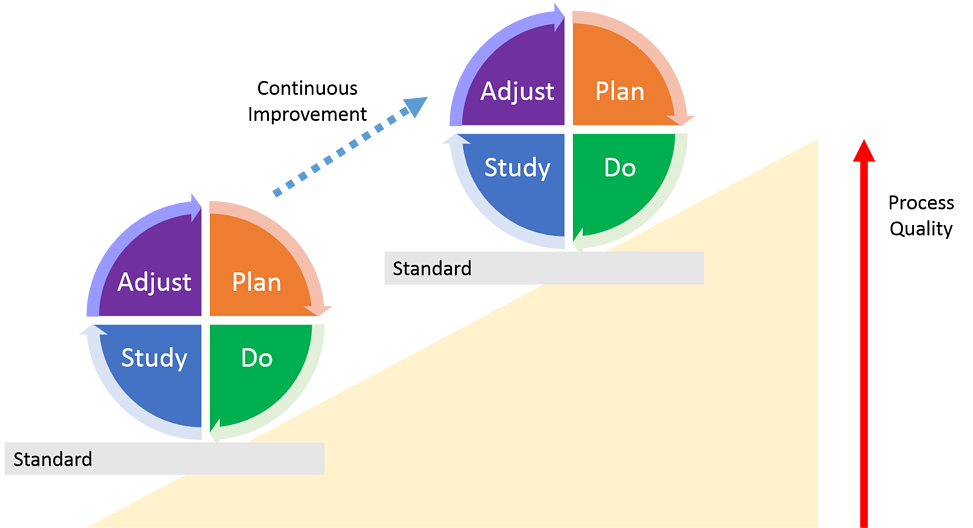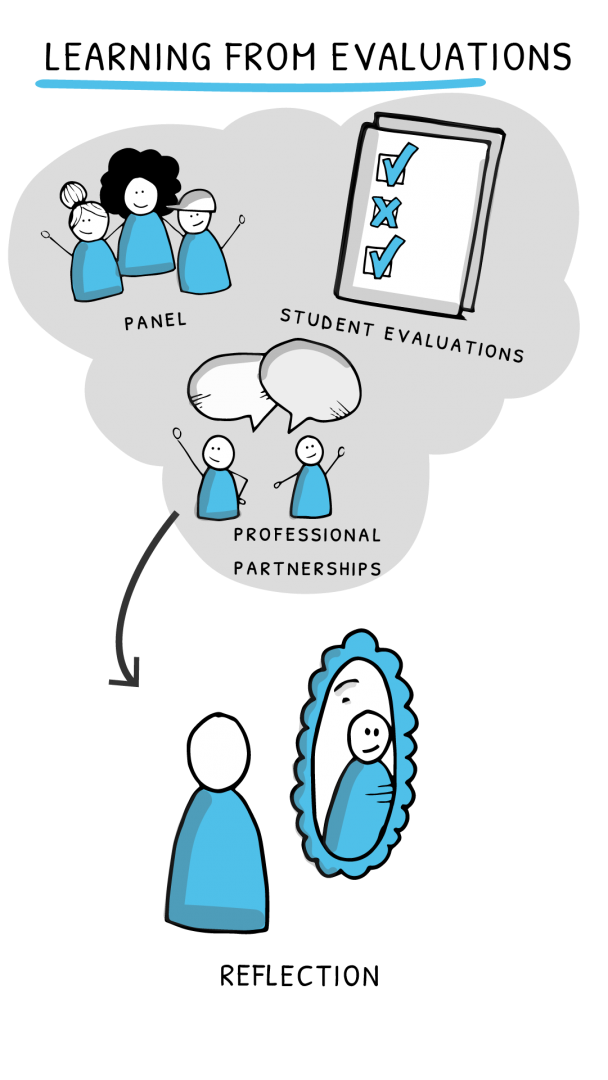Learning from evaluations
Why?
The mission of the AUAS is to educate students to become professionals who have the knowledge and competencies needed to play a prominent role in professional practice and in society. Quality of education is about achieving this mission. It is about us, as an institution, ensuring that students find the education they receive challenging and experience their degree programme as valuable preparation for their careers.
One of the main pillars of education is feedback and reflection. It is important that both students and lecturers learn to review their own actions. Such reflection is also essential to improve the quality of education and research. We use student evaluations, panel discussions with students and discussions with professionals to collect feedback on the education we provide.
It is important also to use this feedback to develop new education or to adapt existing education to include these practices.
What?
According to the AUAS quality policy (NL), AUAS employees are ‘reflective practitioners’ (as per Schön) who work on the basis of knowledge and information (literature, research, dialogue). In other words, our actions are ‘informed’. At FDMCI, we consider cooperation to be essential for processes to be beneficial for the greater good. The FDMCI foundational document (NL) expresses this desire as follows: ‘Employees will have a sufficient number of opportunities to exchange knowledge, thoughts, opinions and experiences.’ We aim to have a culture of feedback, both in education and in the organisation. We want students to be actively involved in designing new or existing curricula and in the development of the FMT portfolios and quality assurance. We want them to see their contributions reflected in the education they receive. A culture of quality is also about reflection and taking informed action.
FDMCI uses the PDSA cycle for systematic reflection. For evaluations, it uses qualitative information and instruments for monitoring and reflection. This information is intended to provide frameworks for use by the management, in consultation with employees and students, in order to formulate improvement measures.
How?
Learning how to give feedback and how to reflect on one’s own actions is embedded at various levels:
1. Opleidingsniveau door accreditaties, midterm reviews, landelijke of HvA-brede onderzoeken en rendementscijfers
-
- Accreditation takes place every six years, with the degree programme organising a midterm review in between accreditations. This review is an external assessment of the programme, using the NVAO’s (NL) quality standards.
- A number of surveys evaluating education are distributed every year on a national basis and by AUAS. These are student satisfaction surveys, such as the Dutch National Student Survey (NSE) (NL), the 100-Day Monitor (NL) the HBO-Monitor (NL) and the EXIT Monitor(NL). In addition, the Education and Research Employee Monitor (NL) is distributed among teaching and research staff at AUAS every two years to gauge their satisfaction about various aspects of education and research.
- Study success rates per degree programme are printed at least twice a year, with admissions, dropout rates, first-year success rates and graduation rates evaluated for each cohort.
These evaluations provide input for the improvement of each degree programme and team. It is important to take this input seriously, as students and lecturers dedicate time to providing the feedback. If we are working to have a culture of feedback, all feedback should be taken seriously.
These programme-level evaluations make no pronouncements about your specific module; however, they can provide general pointers to help adjust it. Use this data in addition to the data on your course, such as the teaching evaluations.
2. Module level through teaching evaluations, study success rates and panel discussions
Degree programmes carry out their own evaluations to determine the quality of the curriculum and the modules. The programmes themselves decide which tools to use for this.
- Most programmes choose to distribute a questionnaire after each module among all students who have participated in it (student evaluations). In addition, some programmes distribute periodical questionnaires among lecturers (lecturer evaluations).
- After each module, success rates are printed that indicate, among other things, the percentages of students who passed or failed the module, who are on schedule or who have study completion delays.
- Panel discussions and/or talks with class representatives are organised periodically to discuss the quality of education with students. The topics for these discussions are chosen based, for example, on the outcomes of the above-mentioned evaluations.
Evaluations of modules tell you something about students’ experience of them. If modules are taught over a longer period, they can also help you understand how they are progressing. Study success rates sometimes allow you to discern trends as well. Panel discussions can be used to evaluate modules in greater depth and to formulate suggestions for improvement together with students.
Use this information to assess your educational offering critically. Learning is never finished. Professional practice, the social context and students change over time, so it is useful to assess this every year.
3. Improving your teaching using feedback from colleagues and students
Aside from the official teaching evaluations, requesting feedback from students and colleagues is a good way of adapting and improving your teaching. This method also signals to students that asking for feedback forms part of the learning process.
You can request feedback on your classes by way of polls and quizzes. Handing out or asking for summaries of your classes is a way of gauging students’ understanding of the study material. Go for low-threshold methods, such as putting up Post-it notes on leaving the classroom or as evaluation. In case of online learning activities, feedback can be collected in, for instance, Wooclap or Padlet or on a Miro board. When students check into a lecture, you can ask them to award smileys or thumbs to indicate what they think is their level of understanding of the material. You can also ask them to sort topics from easiest to hardest. Most importantly, ask for feedback that you can use for your next class, such as feedback about the material, the learning activities and your explanations. This will allow you to improve classes and ensure they provide students with what they need to achieve the desired learning outcomes.
You can also ask a colleague to sit in on one of your classes to provide feedback on your teaching. This is of course easy to arrange with online classes, but it is also possible in the lecture room. Discuss with your colleague which aspects you would like to get feedback on; plan this so you can discuss it at ease. Another idea is to ask a colleague if you can sit in on a class of theirs so as to find inspiration for your own classes. Learning from each other is one of the educational principles at AUAS; it is, of course, very powerful for lecturers to seek to do this as well.
At FDMCI, the degree programmes are responsible for their own quality assurance and for the evaluation of their own modules. Each programme employs at least one quality assurance officer to this end. The quality assurance officers cooperate closely with the programme teams at the programme level and the quality teams at the faculty level. This gives them as complete a picture as possible of the quality of education. The information collected at the various levels is collated, is interpreted together with students and lecturers and is converted into concrete actions for improvement.


